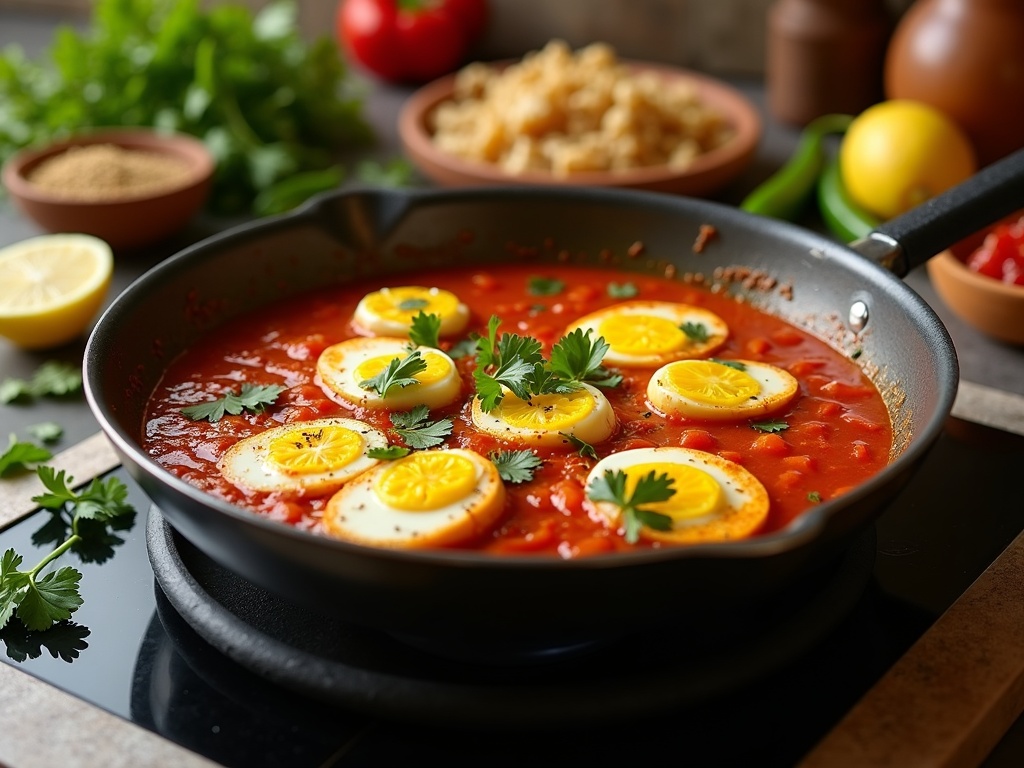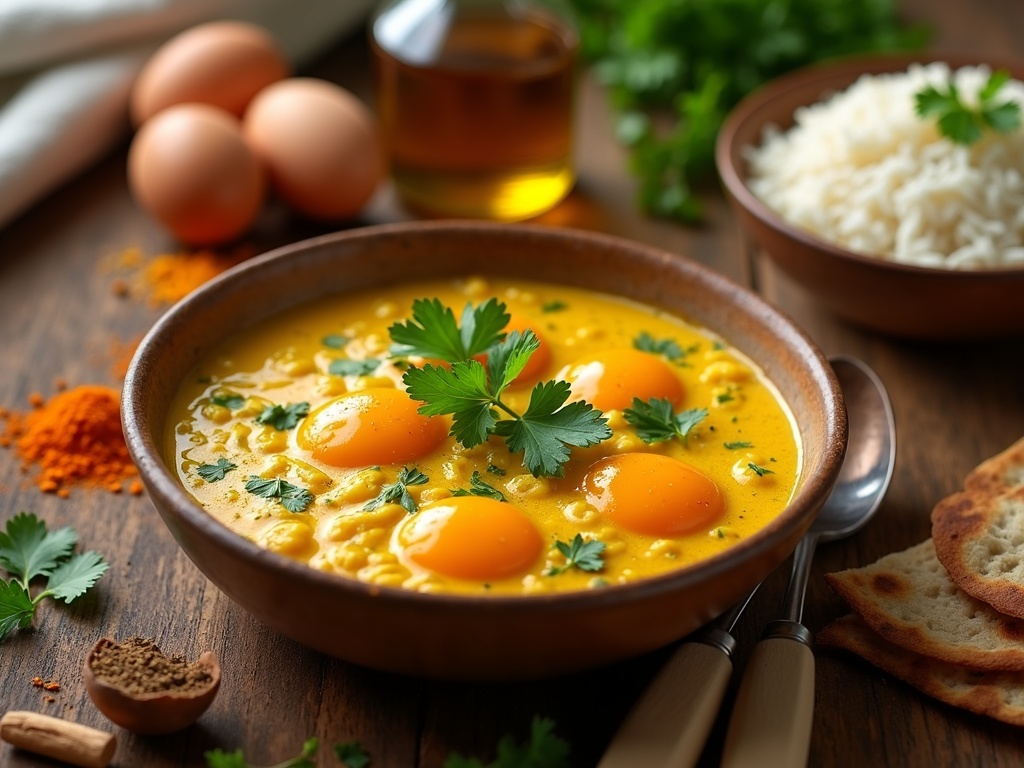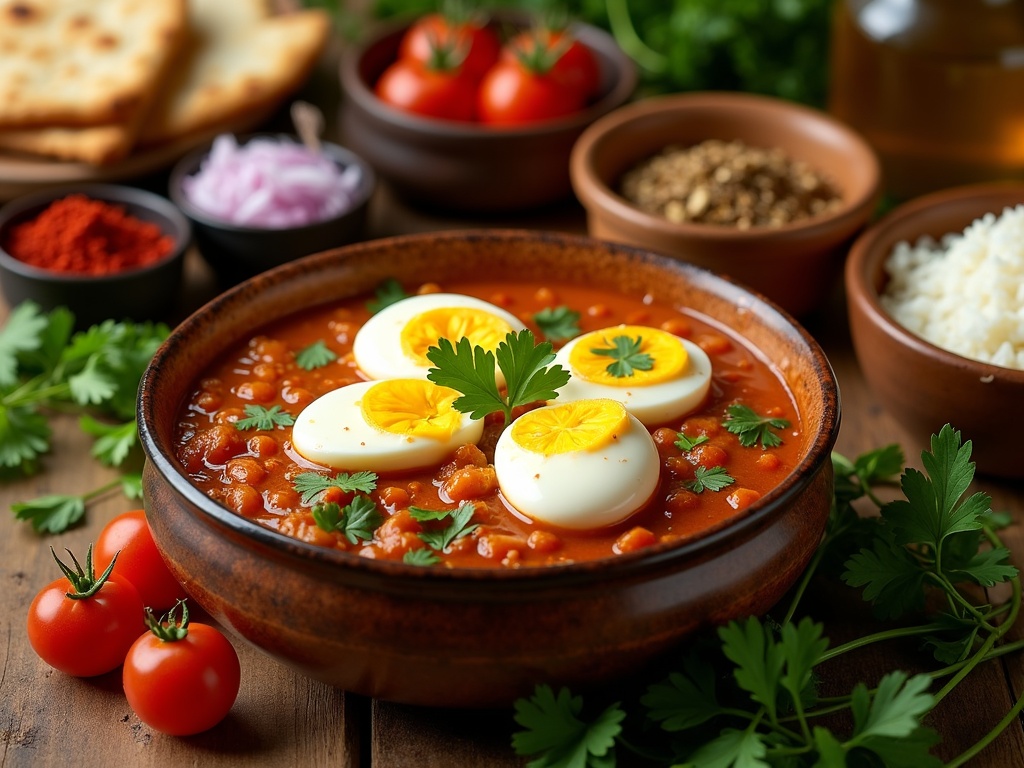Egg curry recipe combines perfectly boiled eggs with a rich, aromatic sauce made from caramelized onions, tomatoes, and a blend of fragrant spices like curry powder, turmeric, and cumin. This versatile dish strikes an ideal balance between protein and flavor, making it a satisfying centerpiece for any meal when paired with rice, naan, or roti.
Find In This Article
Key Takeaways
- Hard-boiled eggs should be cooked for 10-12 minutes and immediately plunged into cold water for easier peeling and to prevent a grayish ring around the yolk.
- The curry’s flavor foundation comes from properly caramelized onions, which should be cooked until golden brown (about 7-8 minutes).
- A single serving provides approximately 12-15 grams of protein with only 220-250 calories, making it a nutritious meal option.
- For a creamier variation, add coconut milk or yogurt to the sauce, or incorporate vegetables like peas and potatoes for added nutrition.
- The dish actually tastes better the next day as flavors continue to develop, making it perfect for meal prep and leftovers.
I’ve found egg curry to be one of the most satisfying and simple dishes in my cooking repertoire. The magic happens when those perfectly cooked eggs absorb the bold, spice-infused sauce. What makes this dish special is how it transforms humble ingredients into something truly exceptional.
The secret lies in precise egg cooking. I boil mine for exactly 11 minutes, then transfer them directly to ice water. This stops the cooking process and creates that perfect jammy yolk without any unappetizing gray layer.
Caramelizing onions properly makes all the difference in the final flavor. I take my time with this step – rushing produces thin, weak curry. The deep golden color indicates the natural sugars have developed, creating that essential flavor base.
For those counting macros, this dish delivers impressive protein with modest calories. I often make a double batch on Sundays for quick weekday lunches that require minimal reheating.
Adding coconut milk creates a more indulgent version that pairs beautifully with plain rice, while yogurt offers tanginess that complements spicier variations. Don’t hesitate to customize with whatever vegetables need using up in your fridge.
The flavors intensify overnight as the eggs continue to soak up the sauce – making day-old egg curry even more delicious than freshly made.
Essential Ingredients for Perfect Egg Curry
A delicious egg curry starts with quality ingredients properly prepared. I’ve found that having everything measured and ready before cooking makes the process much smoother.
The Foundation Components
For a classic egg curry that serves 4 people, I start with 6 hard-boiled eggs. I boil them for 10-12 minutes until the yolks are fully set, then immediately plunge them into cold water. This quick temperature change prevents that grayish ring around the yolk and makes peeling much easier.
The aromatic base consists of 2 medium onions, finely diced. These will caramelize beautifully and form the foundation of your curry flavor. Along with 2 chopped tomatoes that add tanginess and body to the sauce.
I always keep these essential spices on hand:
- 1 tablespoon curry powder (the backbone of the dish)
- ½ teaspoon turmeric for that gorgeous golden color
- 1 teaspoon cumin seeds for aromatic depth
- 1 tablespoon ginger-garlic paste for pungency
- 2-3 green chilies (adjust based on your heat preference)
A tablespoon of cooking oil is all you need – I prefer using mustard oil for its distinctive flavor, but any cooking oil works well. If you’re looking for a creamier variation, you might consider adding some coconut milk or yogurt to the sauce.
The beauty of egg curry lies in its versatility. You can adjust the spice levels to suit your taste, and it pairs wonderfully with rice or bread. For more egg-based dishes, I’ve experimented with various egg dishes that share similar spice profiles.
If you enjoy this recipe, you might also like to try making egg bhurji, which uses many of the same spices but with scrambled eggs instead. Or for a portable option, these ingredients can be modified for a delicious egg sandwich recipe with an Indian twist.
With these quality ingredients prepared properly, you’re setting yourself up for a curry that’s rich in flavor and satisfying in texture – the perfect centerpiece for a family meal.
Step-by-Step Cooking Method
I’m excited to share my foolproof method for creating a delicious egg curry that’s packed with flavor. This recipe strikes the perfect balance between spice and creaminess while keeping the eggs tender and delicious. Let me walk you through each step to ensure your curry turns out perfect every time.
Creating the Aromatic Base
First, I heat oil in a deep pan over medium heat. Once the oil is hot, I add cumin seeds and let them sizzle for 5-10 seconds until they release their distinctive aroma. This step is crucial as it creates the foundation of flavor for your curry.
Next, I add finely chopped onions to the pan and sauté them until they reach a beautiful golden brown color. This usually takes about 7-8 minutes. The caramelization of onions adds a natural sweetness to the curry that balances the spices perfectly.
Once the onions are golden, I add ginger-garlic paste along with finely chopped green chilies. I stir continuously for about a minute to cook off the raw smell of the ginger and garlic. This aromatic mixture forms the backbone of any good curry.
Now comes the spice blend. I sprinkle in curry powder and turmeric, stirring constantly for about 2 minutes. This toasting of spices is essential to develop their complex flavors and eliminate any raw taste. The kitchen starts filling with amazing aromas at this point!
For the next layer of flavor, I add chopped tomatoes to the pan. I cook them until they completely soften and start to break down, usually taking about 5-7 minutes. The tomatoes add tanginess and body to the curry sauce.
Once my base is ready, I gently slide in the boiled and halved eggs. I simmer everything together for 5-10 minutes, allowing the eggs to absorb all those wonderful flavors. I occasionally spoon the sauce over the eggs to ensure they’re evenly coated.
The entire cooking process takes about 30-40 minutes from start to finish, but the result is absolutely worth it. What you’ll get is a richly flavored egg dish with a sauce that’s perfect for scooping up with naan or pouring over rice.
If you’re looking for something a bit different, you might also enjoy my egg bhurji recipe, which uses similar spices but with scrambled eggs instead.
For those who want to take their egg curry to the next level, I recommend adding these finishing touches:
- A sprinkle of fresh cilantro leaves just before serving
- A squeeze of lemon juice to brighten all the flavors
- A dollop of yogurt for extra creaminess
- A pinch of garam masala for aromatic depth
The beauty of this cooking method is its versatility. Once you’ve mastered the base, you can adjust the spices to suit your taste preferences. For a milder version, reduce the chilies and curry powder. For extra protein, add some boiled potatoes or chickpeas.
This egg curry also makes an excellent filling for an egg sandwich the next day, if you happen to have leftovers. Simply mash the curry slightly and spread it between slices of toasted bread for a quick lunch.

Health Benefits and Nutrition
I’ve discovered that egg curry isn’t just delicious—it’s also packed with impressive nutritional benefits. A single cup serving contains approximately 220-250 calories, making it a reasonably light meal option that still satisfies hunger.
Protein Powerhouse
Eggs are one of nature’s perfect protein sources, and this curry showcases them beautifully. Each serving delivers about 12-15 grams of high-quality protein, which is essential for muscle repair and growth. This makes egg bhurji and other egg-based dishes fantastic options for anyone looking to increase their protein intake without consuming excessive calories.
The dish contains approximately 15 grams of fat, primarily from the eggs and cooking oil. While this might seem significant, much of this fat is the beneficial unsaturated kind, especially if you’re using healthier cooking oils like olive or avocado oil. The curry also provides around 10 grams of carbohydrates, significantly lower than meat-based curries that often include starchy fillers.
Vitamin and Mineral Content
I’ve found egg curry to be incredibly nutrient-dense. The eggs in this dish are rich in essential amino acids that your body needs but can’t produce on its own. They’re also an excellent source of vitamin B12, which is crucial for nerve function and the production of DNA and red blood cells.
For those watching their carbohydrate intake, egg dishes like this curry offer a fantastic lower-carb alternative to many traditional meat-based curries. This makes them suitable for various dietary preferences, including low-carb and moderate ketogenic approaches.
The spices typically used in egg curry—such as turmeric, cumin, and coriander—add negligible calories while providing anti-inflammatory benefits and enhancing the dish’s overall nutritional profile.
If you’re looking for ways to incorporate more eggs into your diet beyond curry, an egg sandwich recipe can also provide similar protein benefits in a different format.
What makes egg curry particularly valuable from a nutritional standpoint is its balance—providing substantial protein, moderate healthy fats, and limited carbohydrates in a single satisfying dish that keeps you full for hours without weighing you down.

Creative Variations and Serving Ideas
Transforming a basic egg curry into something extraordinary is easier than you might think. I’ve experimented with countless variations over the years and discovered some fantastic ways to elevate this dish. These creative twists not only enhance the flavor profile but also allow you to customize the curry to suit different occasions and preferences.
Flavorful Variations
Adding coconut milk to your egg curry creates a rich, creamy texture that beautifully balances the spices. I typically stir in about 1/2 cup of coconut milk during the last five minutes of cooking. This simple addition transforms the curry into a more indulgent dish with a subtle sweetness that complements the savory notes.
Vegetables make excellent additions to egg curry, expanding both its nutritional value and visual appeal. I often incorporate green peas, diced potatoes, or carrots to create a more substantial meal. The key is adding harder vegetables earlier in the cooking process, allowing them to soften properly, while quick-cooking vegetables like peas can go in during the final stages.
For a distinctive flavor profile, try incorporating garam masala into your egg curry. Unlike the standard curry powder, garam masala offers warming notes of cinnamon, cloves, and cardamom that give the dish a completely different character. I add about one teaspoon during the last few minutes of cooking to preserve its aromatic qualities.
If you enjoy making different egg dishes, you might also want to try egg bhurji, which shares some similar spices but offers a completely different texture and eating experience.
Serving Suggestions
The accompaniments you choose can dramatically change how your egg curry is enjoyed. Here are some serving ideas that work particularly well:
- Fluffy basmati rice makes a perfect base, absorbing the flavorful curry sauce
- Fresh, hot roti provides a wonderful contrast in texture and allows for scooping up the curry
- Naan bread, either plain or garlic-flavored, adds a chewy, soft element to the meal
- Quinoa or brown rice offer healthier alternatives for a more nutrient-dense meal
Fresh garnishes elevate the presentation and add brightness to egg curry. I always finish my curry with a generous sprinkling of chopped fresh coriander leaves just before serving. The vibrant green color and citrusy aroma enhance both the visual appeal and flavor profile of the dish.
For a complete meal, I pair egg curry with a simple side salad. A combination of sliced cucumbers, tomatoes, and onions with a squeeze of lemon juice and a pinch of salt creates a refreshing contrast to the rich curry. This light accompaniment balances the meal perfectly.
If you’re looking for more egg-based meal ideas, exploring various egg dishes can provide inspiration for your weekly menu. The versatility of eggs makes them perfect for everything from quick breakfasts to elaborate dinners.
For a portable version of these flavors, consider turning your leftover egg curry into a egg sandwich for lunch the next day. Simply spread some curry between two slices of bread with a few fresh vegetables for a delicious repurposed meal.
By playing with these variations and serving ideas, you can enjoy egg curry in numerous ways, making it a versatile addition to your cooking repertoire. The beauty of this dish lies in its adaptability – once you master the basic recipe, the possibilities for customization are nearly endless.
Professional Cooking Tips
Making the perfect egg curry isn’t just about following a recipe—it’s about understanding the techniques that can transform a simple dish into something extraordinary. I’ve learned that small adjustments can make a big difference in flavor, texture, and presentation.
Key Techniques for Exceptional Results
Fresh ingredients are non-negotiable when preparing egg curry. I’ve found that using newly purchased spices rather than those sitting in your cabinet for months creates a dramatically more aromatic and flavorful curry. Fresh tomatoes, onions, and cilantro also contribute brighter flavors than their older counterparts.
Spice levels should always be tailored to your personal preference. While traditional recipes might call for specific amounts of chili powder or green chilies, I suggest starting with less and gradually adding more until you reach your ideal heat level. Remember, you can always add more spice, but you can’t take it away once it’s in the curry.
Proper simmering time is crucial for developing rich, complex flavors. I’ve discovered that rushing this step is a common mistake among home cooks. Allow your curry base to simmer for at least 15-20 minutes before adding the eggs. This patience pays off with a sauce where all flavors have properly melded together.
Achieving golden-brown onions creates incredible depth of taste in your curry. I take the time to properly sauté onions until they develop a rich caramel color—never rushing this step. This caramelization process creates natural sweetness and complexity that forms the foundation of a standout egg curry.
For traditional presentation, keep your eggs whole rather than chopping them. I gently place hard-boiled eggs into the simmering curry, allowing them to absorb the flavors while maintaining their integrity. This method creates an impressive visual appeal and ensures each serving includes a perfect egg.
When making egg bhurji or other egg variations, I scramble the eggs separately before adding them to ensure proper texture control.
The curry actually tastes better the next day as flavors continue to develop overnight. I store leftovers in an airtight container for up to 2 days in the refrigerator. When reheating, I add a splash of water to loosen the sauce and gently warm it on low heat to prevent the eggs from becoming rubbery.
For a complete meal, I serve egg curry with fresh naan, roti, or steamed rice. Sometimes I prepare a quick egg sandwich with leftover curry the next day—the curry serves as a flavorful spread that transforms an ordinary sandwich.
If you’re cooking for guests with varying spice preferences, I recommend preparing the base curry on the milder side, then offering chili oil or fresh chopped chilies on the side. This allows everyone to customize their portion to their preferred heat level.
For added creaminess, I sometimes stir in a tablespoon of yogurt or coconut milk at the end of cooking. This addition helps balance heat while creating a silkier texture that clings beautifully to the eggs and rice.

Sources:
Food Network, USDA National Nutrient Database, Serious Eats, BBC Good Food

